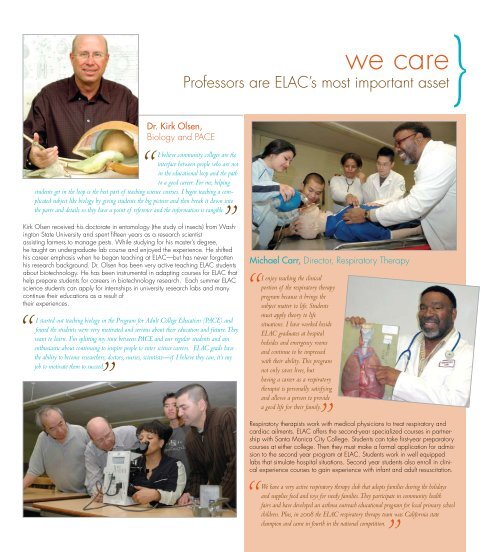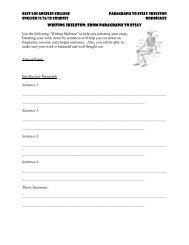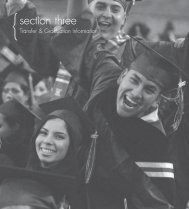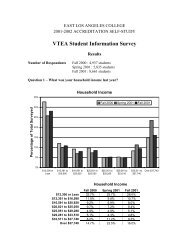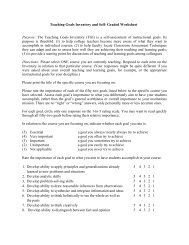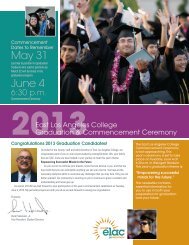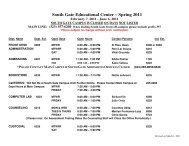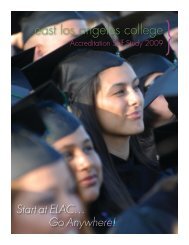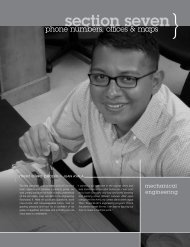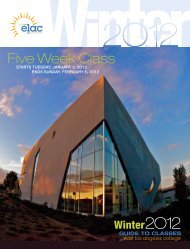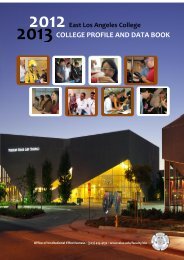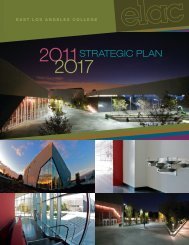Complete Schedule of Classes - East Los Angeles College
Complete Schedule of Classes - East Los Angeles College
Complete Schedule of Classes - East Los Angeles College
- No tags were found...
You also want an ePaper? Increase the reach of your titles
YUMPU automatically turns print PDFs into web optimized ePapers that Google loves.
we carePr<strong>of</strong>essors are Elac’s most important assetDr. Kirk Olsen,Biology and PACEI believe community colleges are theinterface between people who are notin the educational loop and the pathto a good career. For me, helpingstudents get in the loop is the best part <strong>of</strong> teaching science courses. I begin teaching a complicatedsubject like biology by giving students the big picture and then break it down intothe parts and details so they have a point <strong>of</strong> reference and the information is tangible.Kirk Olsen received his doctorate in entomology (the study <strong>of</strong> insects) from WashingtonState University and spent fifteen years as a research scientistassisting farmers to manage pests. While studying for his master’s degree,he taught an undergraduate lab course and enjoyed the experience. He shiftedhis career emphasis when he began teaching at ELAC—but has never forgottenhis research background. Dr. Olsen has been very active teaching ELAC studentsabout biotechnology. He has been instrumental in adapting courses for ELAC thathelp prepare students for careers in biotechnology research. Each summer ELACscience students can apply for internships in university research labs and manycontinue their educations as a result <strong>of</strong>their experiences.I started out teaching biology in the Program for Adult <strong>College</strong> Education (PACE) andfound the students were very motivated and serious about their education and future. Theywant to learn. I’m splitting my time between PACE and our regular students and amenthusiastic about continuing to inspire people to enter science careers. ELAC grads havethe ability to become researchers, doctors, nurses, scientists—if I believe they can, it’s myjob to motivate them to succeed.Michael Carr, Director, Respiratory TherapyI enjoy teaching the clinicalportion <strong>of</strong> the respiratory therapyprogram because it brings thesubject matter to life. Studentsmust apply theory to lifesituations. I have worked besideELAC graduates at hospitalbedsides and emergency roomsand continue to be impressedwith their ability. This programnot only saves lives, buthaving a career as a respiratorytherapist is personally satisfyingand allows a person to providea good life for their family.Respiratory therapists work with medical physicians to treat respiratory andcardiac ailments. ELAC <strong>of</strong>fers the second-year specialized courses in partnershipwith Santa Monica City <strong>College</strong>. Students can take first-year preparatorycourses at either college. Then they must make a formal application for admissionto the second year program at ELAC. Students work in well equippedlabs that simulate hospital situations. Second year students also enroll in clinicalexperience courses to gain experience with infant and adult resuscitation.We have a very active respiratory therapy club that adopts families during the holidaysand supplies food and toys for needy families. They participate in community healthfairs and have developed an asthma outreach educational program for local primary schoolchildren. Plus, in 2008 the ELAC respiratory therapy team was California statechampion and came in fourth in the national competition.


